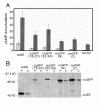A new way to rapidly create functional, fluorescent fusion proteins: random insertion of GFP with an in vitro transposition reaction
- PMID: 12086589
- PMCID: PMC117241
- DOI: 10.1186/1471-2202-3-7
A new way to rapidly create functional, fluorescent fusion proteins: random insertion of GFP with an in vitro transposition reaction
Abstract
Background: The jellyfish green fluorescent protein (GFP) can be inserted into the middle of another protein to produce a functional, fluorescent fusion protein. Finding permissive sites for insertion, however, can be difficult. Here we describe a transposon-based approach for rapidly creating libraries of GFP fusion proteins.
Results: We tested our approach on the glutamate receptor subunit, GluR1, and the G protein subunit, alphas. All of the in-frame GFP insertions produced a fluorescent protein, consistent with the idea that GFP will fold and form a fluorophore when inserted into virtually any domain of another protein. Some of the proteins retained their signaling function, and the random nature of the transposition process revealed permissive sites for insertion that would not have been predicted on the basis of structural or functional models of how that protein works.
Conclusion: This technique should greatly speed the discovery of functional fusion proteins, genetically encodable sensors, and optimized fluorescence resonance energy transfer pairs.
Figures






Similar articles
-
A faster way to make GFP-based biosensors: two new transposons for creating multicolored libraries of fluorescent fusion proteins.BMC Biotechnol. 2004 Aug 18;4:17. doi: 10.1186/1472-6750-4-17. BMC Biotechnol. 2004. PMID: 15317651 Free PMC article.
-
Random insertion of GFP into the cAMP-dependent protein kinase regulatory subunit from Dictyostelium discoideum.Nucleic Acids Res. 1998 Nov 1;26(21):4946-52. doi: 10.1093/nar/26.21.4946. Nucleic Acids Res. 1998. PMID: 9776758 Free PMC article.
-
Regions of alpha-amino-5-methyl-3-hydroxy-4-isoxazole propionic acid receptor subunits that are permissive for the insertion of green fluorescent protein.Neuroscience. 2006 Aug 25;141(2):837-849. doi: 10.1016/j.neuroscience.2006.04.052. Epub 2006 Jun 12. Neuroscience. 2006. PMID: 16765522
-
Insertional gene fusion technology.FEBS Lett. 1999 Aug 20;457(1):1-4. doi: 10.1016/s0014-5793(99)00991-6. FEBS Lett. 1999. PMID: 10486551 Review.
-
Using GFP--ligand fusions to measure receptor-mediated endocytosis in living cells.Vitam Horm. 2002;65:81-95. doi: 10.1016/s0083-6729(02)65060-5. Vitam Horm. 2002. PMID: 12481543 Review.
Cited by
-
Relative positioning of Kv11.1 (hERG) K+ channel cytoplasmic domain-located fluorescent tags toward the plasma membrane.Sci Rep. 2018 Oct 19;8(1):15494. doi: 10.1038/s41598-018-33492-x. Sci Rep. 2018. PMID: 30341381 Free PMC article.
-
Multimodular biosensors reveal a novel platform for activation of G proteins by growth factor receptors.Proc Natl Acad Sci U S A. 2015 Mar 3;112(9):E937-46. doi: 10.1073/pnas.1420140112. Epub 2015 Feb 17. Proc Natl Acad Sci U S A. 2015. PMID: 25713130 Free PMC article.
-
Avoiding the ends: internal epitope tagging of proteins using transposon Tn7.Genetics. 2015 May;200(1):47-58. doi: 10.1534/genetics.114.169482. Epub 2015 Mar 5. Genetics. 2015. PMID: 25745023 Free PMC article.
-
Structural rearrangement of the intracellular domains during AMPA receptor activation.Proc Natl Acad Sci U S A. 2016 Jul 5;113(27):E3950-9. doi: 10.1073/pnas.1601747113. Epub 2016 Jun 16. Proc Natl Acad Sci U S A. 2016. PMID: 27313205 Free PMC article.
-
A vector system for single and tandem expression of cloned genes and multi-colour fluorescent tagging in Haloferax volcanii.Microbiology (Reading). 2024 May;170(5):001461. doi: 10.1099/mic.0.001461. Microbiology (Reading). 2024. PMID: 38787390 Free PMC article.
References
-
- Chalfie M, Tu Y, Euskirchen G, Ward WW, Prasher DC. Green fluorescent protein as a marker for gene expression. Science. 1994;263:802–5. - PubMed
-
- Marshall J, Molloy R, Moss GW, Howe JR, Hughes TE. The jellyfish green fluorescent protein: a new tool for studying ion channel expression and function. Neuron. 1995;14:211–5. - PubMed
-
- Chalfie M. Green fluorescent protein. Photochem Photobiol. 1995;62:651–6. - PubMed
-
- Siegel MS, Isacoff EY. A genetically encoded optical probe of membrane voltage. Neuron. 1997;19:735–41. - PubMed
Publication types
MeSH terms
Substances
Grants and funding
LinkOut - more resources
Full Text Sources
Other Literature Sources

